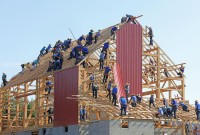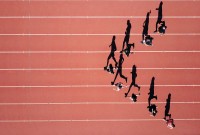- Home
- Business Processes
- Industry Knowledge
- Aerospace Industry
- Automotive Industry
- Banking Domain
- BFSI Industry
- Consumer/ FMCG Industry
- Chemicals Industry
- Engineering & Construction
- Energy Industry
- Education Domain
- Finance Domain
- Hospitality Domain
- Healthcare Industry
- Insurance Domain
- Retail Industry
- Travel and Tourism Domain
- Telecom Industry
- Leadership Skills
- eLearning
- Home
- Leadership
- Leadership Styles
- Theories of Team Development
Theories of Team Development
The development of teams is an ongoing process because the composition of the team may keep on changing. The new members may join and the old members may leave the team. The team members pass through several stages for the development of the team and there has been a lot of research to identify these stages. In this article, we discuss the common theories of team development.
Team is formed as a result of interactions and influence of members who strive for the achievement of common goal. After the formation the teams take time to develop and usually follow some easily recognizable stages, as the team-members transition from being a group of strangers to becoming a unified integrated team chasing a common goal. In this process, the team members try to understand others behavior, realize the appropriateness of the behavior and the roles of the team members. A team is not formed merely by declaring some individuals as a team. A lot of research has been done on group formation and development, and different theories of group development have been suggested. Given below is a list of commonly known theories on team/group development:
- Bennis & Shepard, 1956;
- Bion, 1961;
- Gibb, 1964;
- Schutz, 1958, 1982;
- Tuckman, 1965;
- Tuckman & Jensen, 1977;
- Yalom, 1970;
- Tuckman, 1977;
- Kormanski & Mozenter, 1987;
Now we will discuss some popular theories on team development in detail:
Tuckman’s Five Stage Team Development Model:
Psychologist Bruce Tuckman first came up with the memorable phrase "forming, storming, norming, and performing" back in 1965. The “Forming – Storming – Norming – Performing” model of group development maintained that these phases are all necessary and inevitable in order for the team to grow, to face up to challenges, to tackle problems, to find solutions, to plan work, and to deliver results. This model has become the basis for subsequent models. He used it to describe the path to high-performance that most teams follow. Later, he added a fifth stage that he called "adjourning." Let us learn the five stages briefly:
Forming: This is the first stage of team development. In this stage the members try to explore and understand the behavior of the team members. They make their efforts in understanding the expectations of the team members. At this stage they are polite and try to find out how to fit into the team.
Storming: In the second stage, members start competing for status, leadership and control in the group. Individuals understand others behavior and assert their role in the group. As a result inter-personal conflict starts. Members try to resolve the issues related to the task and working relations. They also resolve the issues related to the role of the individual in the group.
Norming: The members start moving in a cohesive manner. They establish a balance among various conflicting forces. They develop group norms and consensus for the achievement of the group goal. At this stage, cooperative feelings develop among the team members.
Performing: In this stage, the team makes effort for the performance of task and accomplishment of objectives. The established pattern of relationships improves coordination and helps in resolving conflicts. Members trust each other and extend their full cooperation for the achievement of the group goal.
Adjourning: As you must be aware that the team is formed for some purpose. When this purpose is fulfilled, the team may be adjourned. Thus, the breaking up of the team is referred to adjournment.
Kormanski & Mozenter (1987) Stages of Team Development:
Kormanski & Mozenter (1987) integrated the various theories and suggested the following stages of team development. These stages are sequential (each stage is followed by the next one). Each stage has a task outcome and a relationships outcome. Kormanski and Mozenter have identified following stages of team development :
- Awareness
- Conflict
- Cooperation
- Productivity, and
- Separation
1. Awareness: At this stage individuals get to know each other. By knowing the goals of the team they commit themselves to the goals. The members get to know and accept to work together for a goal about which they have enough knowledge.
2. Conflict: At the first stage (awareness) the members know the team goals and accept to work together; but this is at the surface level. At the second stage they search and begin to ask questions. As a result several matters are clarified. They also fight with each and in this process of interaction resolve any hostilities they may have, resulting in the feeling of belonging to the group.
3. Cooperation: In the third stage the members own the team goals and get involved in those goals. Having resolved feelings, they also support each other.
4. Productivity: This is the stage of real achievement of the goals/outcomes, and the team members achieving these objectives feel proud of their achievement.
5. Separation: Having accomplished the goals or the outcomes, some task-specific teams may decide to get dissolved, or a time-bound time comes to a close. The excellent work done by the members is recognized, and the team members have a high sense of satisfaction of working with each other. This is the stage of closure of the team, or closure of one task on which the team was working.
The following table provides a summary of task outcomes and relationships outcomes at each stage as defined in the model:
|
A Model of Team Building |
|||
|
Stage |
Theme |
Task Outcome |
Relationship Outcome |
|
One |
Awareness |
Commitment |
Acceptance |
|
Two |
Conflict |
Clarification |
Belonging |
|
Three |
Cooperation |
Involvement |
Support |
|
Four |
Productivity |
Achievement |
Pride |
|
Five |
Separation |
Recognition |
Satisfaction |
Related Links
You May Also Like
-
McClelland's Theory of Needs is a human motivation theory which states that an individual's specific needs are acquired over time through our culture and life experiences. As per the three needs theory, these acquired needs significantly influence the behavior of an individual. The three main driving motivators are the needs for achievement, affiliation, and power.
-
Participative Leadership Theories
Participative leadership theories rely on the involvement of different participants and suggest that the ideal leadership style is one that takes the inputs of others into account. Participative leaders encourage participation and contributions from group members and involve them in the decision-making process. Participative leadership tries to achieve through people, teamwork and collaboration.
-
Theory Z also called the "Japanese Management" style is a leadership theory of human motivation focused on organizational behavior, communication, and development. It assumes that employees want to enter into long term partnerships with their employers and peers. Offering stable jobs with an associated focus on the well-being of employees results in increased employee loyalty to the company.
-
Leadership Participation Inventory (LPI)
Kouzes and Posner introduced the Leadership Participation Inventory model of Transformational leadership. This model is also known as Kouzes and Posner's Leadership Challenge Model. They identified five practices of exemplary leadership - Model the Way, Inspire a Shared Vision, Challenge the Process, Enabling Others to Act, and Encourage the Heart.
-
Transactional Analysis also is known as the theory of human personality was proposed by Eric Berne in the 1950s. This theory of transactional leadership defines three different ego states in a person who engages in transactions with another person's ego states. These three ego states refer to major parts of an individual's personality and reflect an entire system of thought, feeling, and behavior.
-
Process & Stages of Creativity
Creative ideas do not come just like that. There is a process to it. There are a number of techniques of creativity to support the generation of ideas but the widely practiced ones are brainstorming and lateral thinking. Most innovations are not so much the product of sudden insights as they are the result of a conscious process that often goes through multiple stages. The creative process can be divided into four stages of preparation, incubation, evaluation, and implementation.
-
The psychodynamic approach to leadership has its roots in the work done by Sigmund Freud. These involved psychological theories of personality development and explaining leadership using psychoanalytic concepts. It tries to define a person is in terms of personality traits. Personality structured into three parts (i.e., tripartite) - the id, ego, and superego.
-
Humanistic theories of Leadership
Humanistic leadership is an ethical philosophic approach that recognizes the dignity and worth of each and every group or team member. This approach is based on building a leadership culture of trust, ethics, and empathy. Humanistic leadership is a set of principles founded on humanism with vision, mission, values, and expected behaviors. It is value-driven leadership based on principles such as humility, accountability, positivity, and love.
-
Bass's Transformational Leadership Theory
Bass Transformational Leadership Theory is based on performance beyond expectations approach which defines four elements of transformational leadership. The 4 elements described by Bernard A. Bass in 1985 are Idealised Influence, Intellectual Stimulation, Individualised Consideration, and Inspirational Motivation. This study highlights four key insights about performance beyond expectations and associated criteria to measure it.
-
Self-Fulfilling Prophecy (SFP) Leader Theory
Pygmalion theory of Leadership is a model of SFP at work involving supervisory expectancy based on the pygmalion effect. This effect is a type of self-fulfilling prophecy (SFP) in which raising leader's expectations regarding subordinate performance boosts the group's performance. Managers who are led to demand more from their team, lead the team to better performance. There is some evidence that the SFP effect does exists.
Explore Our Free Training Articles or
Sign Up to Start With Our eLearning Courses

About Us
Learning
© 2023 TechnoFunc, All Rights Reserved










